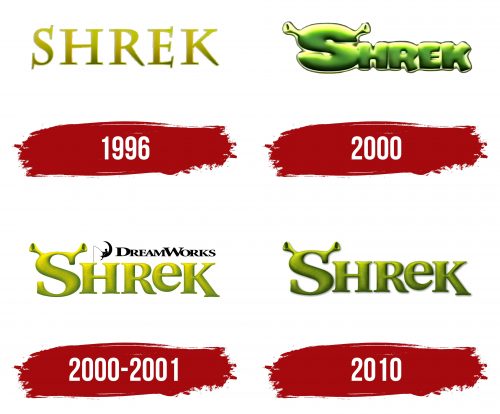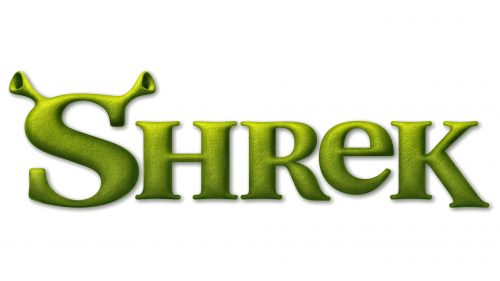The Shrek logo is animated and lively. Each element of the emblem seems like a part of a moving caterpillar, hinting at the theme of magical transformations of the unrefined and sloppy hero with green skin.
Shrek: Brand overview
In 1990, William Steig introduced the world to “Shrek,” a children’s book about an unsightly yet endearing ogre whose quest for solitude leads him on a journey after his swamp becomes a haven for displaced fairytale beings. This unique story laid the groundwork for a major cinematic endeavor when DreamWorks Animation, seeing the potential in Steig’s creation, secured the rights to bring Shrek to the big screen in the mid-1990s.
With Jeffrey Katzenberg at the helm of DreamWorks SKG, the studio enlisted the expertise of Pacific Data Images (PDI) to pioneer the ambitious project. The result was the groundbreaking “Shrek,” released in May 2001. This film, under the direction of Andrew Adamson and Vicky Jenson, featured the vocal talents of Mike Myers, Eddie Murphy, and Cameron Diaz. It brought to life the vivid universe of Steig’s book with a fresh, comedic twist on classic fairy tales, blending wit, humor, and warmth to critical and commercial acclaim.
“Shrek” revolutionized animated films with its all-computer animation and set a new standard for storytelling, merging humor with a touching narrative. Its overwhelming success at the box office led to a franchise, including three more animated sequels: “Shrek 2” in 2004, “Shrek the Third” in 2007, and “Shrek Forever After” in 2010, each contributing to the saga of the beloved ogre and his fairytale companions.
Over the years, “Shrek” has expanded beyond the silver screen to include spinoffs and theme park attractions, cementing its status as a cultural phenomenon. The franchise’s enduring popularity underscores the timeless appeal of its characters and the innovative spirit of its creators, who transformed a simple picture book into an entertainment legacy.
Meaning and History
Beloved by children, Shrek did not immediately appear on screens. A 4-year preparation preceded this. However, logos for prototypes and subsequent series always consisted of the name of the animated film. Unique details of the main character’s image, added to the letters, make the inscription special.
What is Shrek?
A series of animated films shot by DreamWorks Animation based on the fairy tale by William Steig. To date, there have been four feature films, two spin-offs, and six short films between 2001 and 2022. Many franchise products are sold, including toys and video games.
1996 (prototype)
Initially, the logo was intended to be a standard inscription with serifs. The only fairy-tale element was a gradient from green to yellow, which was supposed to reflect the changes from a beautiful princess to a green ogre.
The lengthy work on the project led to a reconsideration of the approach to the character’s image and its emblem. Disagreements and disputes were so serious that the first team of animators resigned. Today, we know a completely different Shrek, which was not planned initially. Therefore, more unique details were added to the logo.
2000 (prototype)
The green letters of the inscription gained volume to emphasize the rounded shapes of the hero. Cute ears were added to the first capital letter S, precisely replicating Shrek’s image. The inscription seems to be bathed in golden sunlight from above, and each symbol glows. The idea indicated:
- The elements of fairy tale and magic are present in the story. Even an ogre can experience love and find happiness.
- The peculiarity of the princess, whose life and appearance depended on the sunrise and sunset.
- The finale is in which Fiona chooses to remain green and large even in the sunlight for love.
The angular letters of the inscription show Shrek’s rough character—his unpleasant manners. Interestingly, the character’s image was based on a real person – American wrestler Maurice Tillet, who suffered from acromegaly and looked like a real monster but remained very shy and kind.
2000 – 2001
The final logo that viewers saw transformed a bit. The letters of the inscription stretched upwards more to convey the imposing size of ogres compared to ordinary people.
Serifs returned to the inscription to highlight the sharp, prickly nature of the character, which he showed to the world. Lighter tones added appeal to the sign, hinting at the shyness and hidden kindness of the main character.
2010
In the fourth part of the story, Shrek Forever After, which came out in 2010, a new emblem appeared. It received darker colors and a shortened leg of the letter K. Otherwise, the sign was a little different from the previous one.
Font and Colors
The green shades of the logo evoke associations with the swamp where the main character lived—his fondness for bathing in mud and brushing his teeth with green caterpillars. Interestingly, the prototype for Shrek’s dwelling was the real Audubon Swamp, with its many green shades, visited by the artistic director of the film.
The palette was also chosen in tune with the color of the ogre’s skin and that of his beloved. The dark green colors are not about a romantic fairy tale of princesses. They present to viewers a completely new fairy-tale world, where familiar characters are shown in entirely new forms. The entire animated film is a subtle parody of Walt Disney’s animation.
Adding a yellow gradient to almost every version of the emblem makes the story warmer and more lively.
The font of the logo is unique due to the ears on the letter S and the lowercase ‘e’ among the uppercase elements. The small letter, hidden in the middle of the inscription, hinted at Shrek’s kind heart, which he diligently hides behind roughness and feigned indifference.










